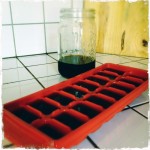Fig Follow Up
I have a fig tree too, just like Fran, and every other Italian woman with a small piece of land in the tri-state area. But mine doesn’t have roots in Brooklyn. Honestly, I can’t remember where mine came from—I think Home Depot. But I’ve had the tree for about 15 years, though she’s more of a twig than a tree. She first lived in a container on a roof deck, a lifetime ago when I was in Ridgewood, Queens. When the move to Rockaway happened, she spent the next 10 years in a large sauce pot, indoors. It’s a miracle she survived so long in such depressing conditions.
One year, she ventured outside, still in her pot, but a squirrel ate the only fig, and a branch broke. Fearing for her life, I confined her back inside.
But this year, I was tired of the sadness and realized that while there was a risk she could die, the possibility of a new life was worth the chance.
It was mid-summer, the worst time to plant a shrub or tree, but I had a strong urge to do it, to put her in the earth where a tree naturally belongs. At first, she struggled to adjust, but with time, I noticed signs of recovery. Her form stopped drooping, and it seemed her roots were finally taking hold. Just the other day, I saw new sprouts—she’s flourishing.
Take the chance.
Fig trees in the Northeast are delicate during winter since they’re Mediterranean by nature (just like me). Though my fig tree is old, she’s fragile from years of captivity, so I’ll be treating her like a young sapling this winter, giving her all the protection she needs.
Here’s how to care for a young (or young-at-heart) fig tree in NYC (Zone 7b):
- Water Before First Frost: Give the tree a good soak before the ground freezes to help it endure the dry winter months.
- Prune in Late Fall: Trim back damaged or weak branches to reduce stress on the tree and make it easier to wrap for winter.
- Mulch Around the Base: Apply a thick layer of mulch (4–6 inches) around the base to insulate the roots.
- Wrap the Tree: After the leaves fall, wrap the fig tree in layers of burlap or frost cloth to protect it from cold winds. You can carefully tie the branches up to make wrapping easier.
- Insulate with Straw or Leaves: Once the tree is wrapped, you can add straw, leaves, or even bubble wrap around the tree for extra insulation, especially around the trunk. You can also add a cage wire frame to stuff the organic insulation into.
- Cover with a Tarp: On top of the wrapped tree, place a plastic tarp to protect it from rain and snow, but leave room at the bottom for air circulation to prevent mold.
- Unwrap Gradually in Spring: As temperatures warm in the spring, slowly remove the wraps and mulch to avoid shocking the tree with sudden exposure.
Take care and follow these steps to help your fig tree survive the colder months and thrive in the growing season!
Follow me on IG (@theglorifiedtomato) this fall. There’s still so much to do in the garden! If you missed Fran Honan’s column last week, “Roots In Brooklyn” find it here.
























